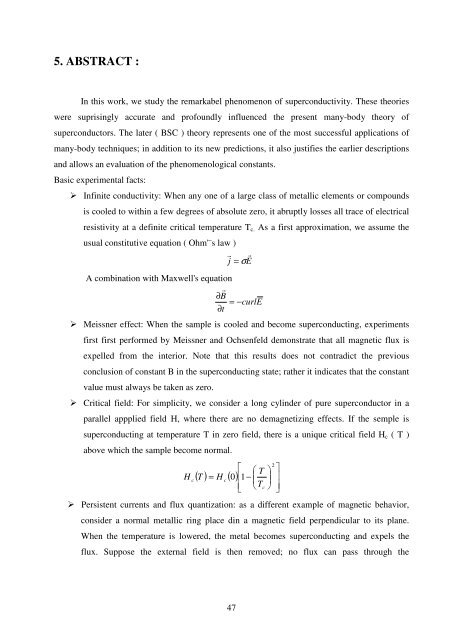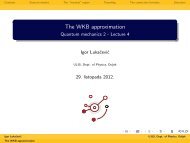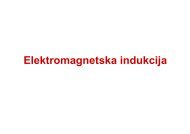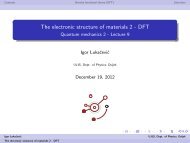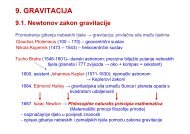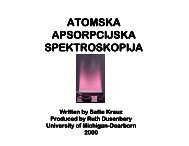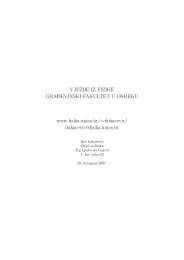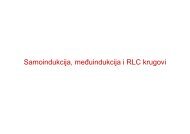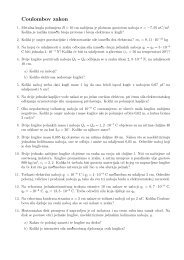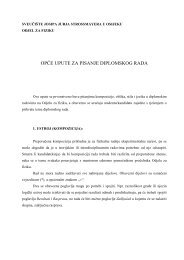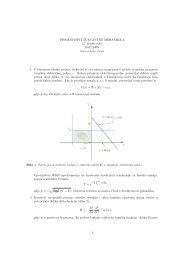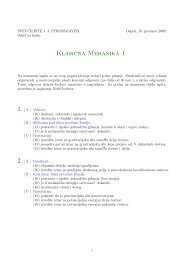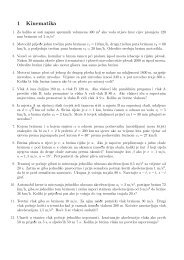fenomenoloÅ¡ka teorija supravodljivosti - Odjel za fiziku - SveuÄiliÅ¡te ...
fenomenoloÅ¡ka teorija supravodljivosti - Odjel za fiziku - SveuÄiliÅ¡te ...
fenomenoloÅ¡ka teorija supravodljivosti - Odjel za fiziku - SveuÄiliÅ¡te ...
Create successful ePaper yourself
Turn your PDF publications into a flip-book with our unique Google optimized e-Paper software.
5. ABSTRACT :<br />
In this work, we study the remarkabel phenomenon of superconductivity. These theories<br />
were suprisingly accurate and profoundly influenced the present many-body theory of<br />
superconductors. The later ( BSC ) theory represents one of the most successful applications of<br />
many-body techniques; in addition to its new predictions, it also justifies the earlier descriptions<br />
and allows an evaluation of the phenomenological constants.<br />
Basic experimental facts:<br />
Infinite conductivity: When any one of a large class of metallic elements or compounds<br />
is cooled to within a few degrees of absolute zero, it abruptly losses all trace of electrical<br />
resistivity at a definite critical temperature T c. As a first approximation, we assume the<br />
usual constitutive equation ( Ohm'¨s law )<br />
r r<br />
j = σE<br />
A combination with Maxwell's equation<br />
∂B<br />
r<br />
= − curlE<br />
∂t<br />
Meissner effect: When the sample is cooled and become superconducting, experiments<br />
first first performed by Meissner and Ochsenfeld demonstrate that all magnetic flux is<br />
expelled from the interior. Note that this results does not contradict the previous<br />
conclusion of constant B in the superconducting state; rather it indicates that the constant<br />
value must always be taken as zero.<br />
Critical field: For simplicity, we consider a long cylinder of pure superconductor in a<br />
parallel appplied field H, where there are no demagnetizing effects. If the semple is<br />
superconducting at temperature T in zero field, there is a unique critical field H c ( T )<br />
above which the sample become normal.<br />
H<br />
c<br />
( T ) = H ( 0)<br />
c<br />
⎡ ⎛<br />
⎢1<br />
−<br />
⎜<br />
⎢⎣<br />
⎝<br />
Persistent currents and flux quanti<strong>za</strong>tion: as a different example of magnetic behavior,<br />
consider a normal metallic ring place din a magnetic field perpendicular to its plane.<br />
When the temperature is lowered, the metal becomes superconducting and expels the<br />
flux. Suppose the external field is then removed; no flux can pass through the<br />
T<br />
T<br />
c<br />
2<br />
⎞ ⎤<br />
⎟ ⎥<br />
⎠ ⎥⎦<br />
47


